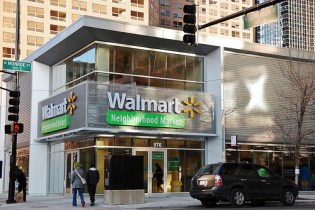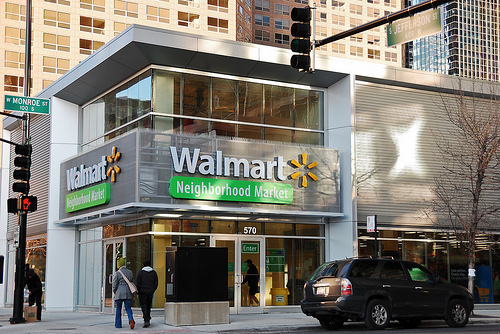
One of the new, smaller "neighborhood markets" Walmart has been opening in urban areas.
Reforming our food system is a Herculean task; one that might intimidate Hercules himself. Willie Nelson and Anna Lappe summed up the challenge recently on the Huffington Post:
Of the 40,000 food items in a typical U.S. grocery store, more than half are now brought to us by just 10 corporations. Today, three companies process more than 70 percent of all U.S. beef, Tyson, Cargill and JBS. More than 90 percent of soybean seeds and 80 percent of corn seeds used in the United States are sold by just one company: Monsanto. Four companies are responsible for up to 90 percent of the global trade in grain. And one in four food dollars is spent at Walmart.
Meanwhile, author Eric Schlosser and urban agriculture pioneer Will Allen put the consequences of all this in sharp perspective in their afterword to the recently published book based on a 2011 Prince of Wales speech on the importance of sustainable agriculture. The essay reads:
Young children and people of color are being hurt the most. During the past 40 years, the obesity rate among American preschoolers has doubled. Among children aged six to 11, it has tripled. Obesity has been linked to cancer, heart disease, and diabetes … As upper-middle-class consumers increasingly seek out healthier foods, the fast food chains are targeting low-income, minority communities — much like the tobacco companies did, when wealthy and well-educated people began to quit smoking.
… Access to good, healthy food shouldn’t be reserved for a privileged few. It should be a basic right.
And they’re right, of course. We need a solution that applies to everyone — not just to those who can afford to opt out of the industrialized food system.
There are those working on this issue, including many in the Obama administration, who believe the key to turning back the tide is getting companies like Walmart to provide access to healthy foods in areas that lack it. And, as Grist reported recently, the Arkansas-based behemoth is well on its way to taking over the food system even without government encouragement. In 2011, Walmart pocketed at least a quarter of all U.S. spending on groceries and accounted for over 50 percent of grocery sales in 29 metropolitan markets.
Meanwhile, a new report from Food and Water Watch (FWW) argues that, not only is Walmart’s dominance problematic in general, but the company’s recent projection of itself as a food system savior is misleading. As the report concludes:
Walmart’s model is based on practices that drive consolidation; take money away from farmers, workers, and processors; and drive agriculture to get more industrialized. Walmart’s model is part of the problem, which means the company is not going to be a meaningful part of the solution to shortcomings in the modern-day food supply.
Of course, that assertion addresses only one side of the equation, the business of food production and distribution — and therein lies the flaw in the argument, according to some.
Those whose focus is on the health of our communities and on the pernicious effects of obesity and diabetes say that Walmart’s unmatched ability to provide affordable access to healthy foods like fruits and vegetables, especially in areas that currently lack them, outweighs the potential negative effects the FWW report describes.
But a recent study published in the Cambridge Journal of Regions, Economy and Society suggests that communities that invite Walmart in may be making a devil’s bargain. The study found strong evidence that communities that rely on big box retailers — and large corporate employers in general — are less healthy and have higher rates of obesity and diabetes than those that don’t.
A team of sociologists from Louisiana State University and Baylor decided to look for a link between small business density and population health. The presumption historically has been to associate small businesses with less-healthy communities, since larger companies tend to pay higher wages and offer their employees better health care coverage.
However, the researchers found that, despite the advantages that employees of large companies have in income and benefits, communities as a whole who relied on small businesses were more healthy otherwise. As they put it, “The concentration of small businesses is associated with lower rates of mortality, obesity and diabetes.”
Strikingly, they also found that:
… the presence of large retailers has a detrimental effect on two population health measures. In terms of the age-adjusted rate of mortality and the percent of adults obese, the presence of large retailers is related to poorer health outcomes. Large big box retail operations are not conducive to improving community health, net of other important business sector and demographic controls.
The researcher’s explanation is simple:
[S]mall-business owners were motivated to help solve local problems because community improvement enhanced their quality of life and the profitability of their business. In contrast, communities lacking a strong small business sector demonstrated a diminished capacity to address local problems.
In other words, sending the Walmarts of the world into communities to “save them” isn’t necessary — and there is growing evidence that it’s outright harmful, despite what their corporate PR might want you to think.
Supporting and encouraging small businesses isn’t parochial or anti-progress. It’s good for your health.
The second study I ran across simply confirms that people don’t need cheap fruits and vegetables as much as they need access to them at all. The study, published in the journal Public Health Nutrition, examined fruit and vegetable consumption among low-income Chicago residents. As the Washington Post reported, researchers:
… found that convenience was key among those who eat more produce. Participants who agreed that they had ‘convenient access to quality’ produce were more than twice as likely to eat the FDA-recommended amounts of fruits and vegetables, compared to those who said they did not have such access … Those who reported high cost as a barrier to the consumption of produce ended up eating just as much as those who didn’t.
A big part of Walmart’s value proposition is the low prices it offers. But that may not be a major factor holding back consumption, even in low-income neighborhoods. As a result, programs like the Healthy Corner Store initiative in Philadelphia, which put fresh produce in mom-and-pop stores (i.e. small businesses), might be the way to go to boost consumption. Again, no need for Walmart.
Of course, this isn’t just about one company, no matter how big. It’s about what kind of economy we want. And if this research is borne out elsewhere, it just may be that we can’t have healthy communities without small businesses to drive the changes we need.



